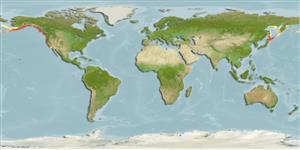Common names from other countries
Classification / Names / Names
आम नाम | उपशब्द | Catalog of Fishes (gen., sp.) | ITIS | CoL | WoRMS
Environment: milieu / climate zone / depth range / distribution range
पारिस्थितिकी
; गहराई सीमा 0 - 200 m (Ref. 114918). Temperate, preferred 5°C (Ref. 107945); 68°N - 32°N, 167°W - 164°E
Arctic, Northwest and Eastern Pacific: from California (San Diego), Alaska, Chukchi Sea and Aleutian Islands to Kamchatka and northern Japan (Hokkaido). Subtropical to boreal.
Length at first maturity / आकार / वज़न / Age
Maturity: Lm ? range ? - ? cm Max length : 14.0 cm SHL पुल्लिंग / अलिंग; (Ref. 95344); अधिकतम सूचित उम्र: 18 वर्षो (Ref. 8702)
Found along the intertidal zone, in sheltered areas in sand-gravel substrate (Ref. 95344).
Life cycle and mating behavior
परिपक्व अवधि | पुनरुत्पत्ति | मछलीऔ का अंडे देना | अंडे | Fecundity | लार्वा
Members of the class Bivalvia are mostly gonochoric, some are protandric hermaphrodites. Life cycle: Embryos develop into free-swimming trocophore larvae, succeeded by the bivalve veliger, resembling a miniature clam.
GBIF. 2007. (Ref. 8310)
IUCN Red List Status (Ref. 130435)
CITES status (Ref. 108899)
Not Evaluated
Not Evaluated
Human uses
मात्स्यिकी: व्यापारिक
FAO - मात्स्यिकी: landings | FishSource | Sea Around Us
साधन
इंटरनेट स्रोत
Estimates based on models
Preferred temperature
(Ref.
115969): 4.6 - 14.3, mean 8.8 (based on 266 cells).
